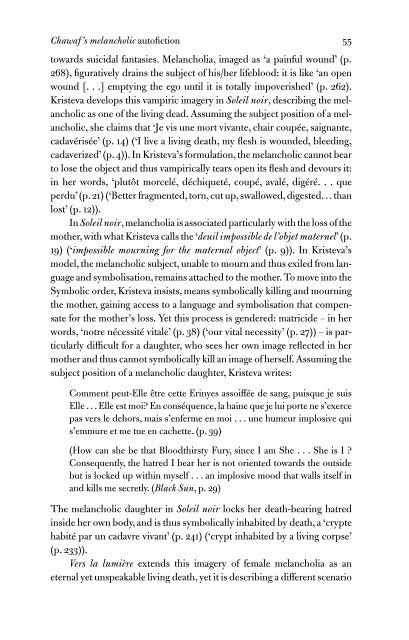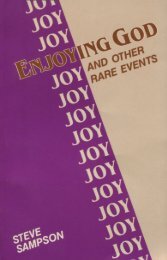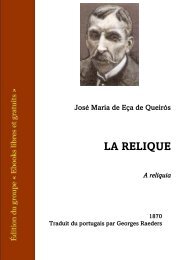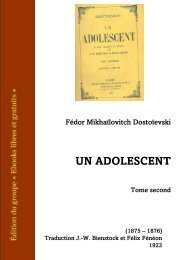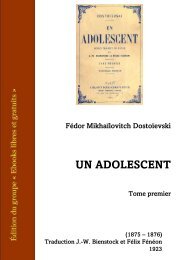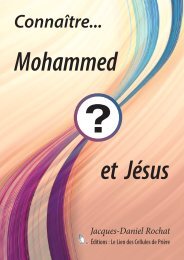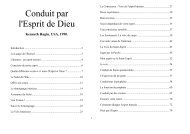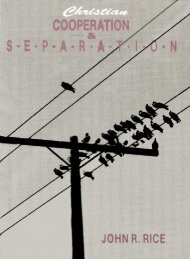Women writing in contemporary France
Create successful ePaper yourself
Turn your PDF publications into a flip-book with our unique Google optimized e-Paper software.
Chawaf ’s melancholic autofiction 55<br />
towards suicidal fantasies. Melancholia, imaged as ‘a pa<strong>in</strong>ful wound’ (p.<br />
268), figuratively dra<strong>in</strong>s the subject of his/her lifeblood: it is like ‘an open<br />
wound [. . .] empty<strong>in</strong>g the ego until it is totally impoverished’ (p. 262).<br />
Kristeva develops this vampiric imagery <strong>in</strong> Soleil noir, describ<strong>in</strong>g the melancholic<br />
as one of the liv<strong>in</strong>g dead. Assum<strong>in</strong>g the subject position of a melancholic,<br />
she claims that ‘Je vis une mort vivante, chair coupée, saignante,<br />
cadavérisée’ (p. 14) (‘I live a liv<strong>in</strong>g death, my flesh is wounded, bleed<strong>in</strong>g,<br />
cadaverized’ (p. 4)). In Kristeva’s formulation, the melancholic cannot bear<br />
to lose the object and thus vampirically tears open its flesh and devours it:<br />
<strong>in</strong> her words, ‘plutôt morcelé, déchiqueté, coupé, avalé, digéré. . . que<br />
perdu’ (p. 21) (‘Better fragmented, torn, cut up, swallowed, digested. . . than<br />
lost’ (p. 12)).<br />
In Soleil noir,melancholia is associated particularly with the loss of the<br />
mother, with what Kristeva calls the ‘deuil impossible de l’objet maternel’ (p.<br />
19) (‘impossible mourn<strong>in</strong>g for the maternal object’ (p. 9)). In Kristeva’s<br />
model, the melancholic subject, unable to mourn and thus exiled from language<br />
and symbolisation, rema<strong>in</strong>s attached to the mother. To move <strong>in</strong>to the<br />
Symbolic order, Kristeva <strong>in</strong>sists, means symbolically kill<strong>in</strong>g and mourn<strong>in</strong>g<br />
the mother, ga<strong>in</strong><strong>in</strong>g access to a language and symbolisation that compensate<br />
for the mother’s loss. Yet this process is gendered: matricide – <strong>in</strong> her<br />
words, ‘notre nécessité vitale’ (p. 38) (‘our vital necessity’ (p. 27)) – is particularly<br />
difficult for a daughter, who sees her own image reflected <strong>in</strong> her<br />
mother and thus cannot symbolically kill an image of herself. Assum<strong>in</strong>g the<br />
subject position of a melancholic daughter, Kristeva writes:<br />
Comment peut-Elle être cette Er<strong>in</strong>yes assoiffée de sang, puisque je suis<br />
Elle . . . Elle est moi? En conséquence, la ha<strong>in</strong>e que je lui porte ne s’exerce<br />
pas vers le dehors, mais s’enferme en moi . . . une humeur implosive qui<br />
s’emmure et me tue en cachette. (p. 39)<br />
(How can she be that Bloodthirsty Fury, s<strong>in</strong>ce I am She . . . She is I ?<br />
Consequently, the hatred I bear her is not oriented towards the outside<br />
but is locked up with<strong>in</strong> myself . . . an implosive mood that walls itself <strong>in</strong><br />
and kills me secretly. (Black Sun,p.29)<br />
The melancholic daughter <strong>in</strong> Soleil noir locks her death-bear<strong>in</strong>g hatred<br />
<strong>in</strong>side her own body, and is thus symbolically <strong>in</strong>habited by death, a ‘crypte<br />
habité par un cadavre vivant’ (p. 241) (‘crypt <strong>in</strong>habited by a liv<strong>in</strong>g corpse’<br />
(p. 233)).<br />
Vers la lumière extends this imagery of female melancholia as an<br />
eternal yet unspeakable liv<strong>in</strong>g death, yet it is describ<strong>in</strong>g a different scenario


